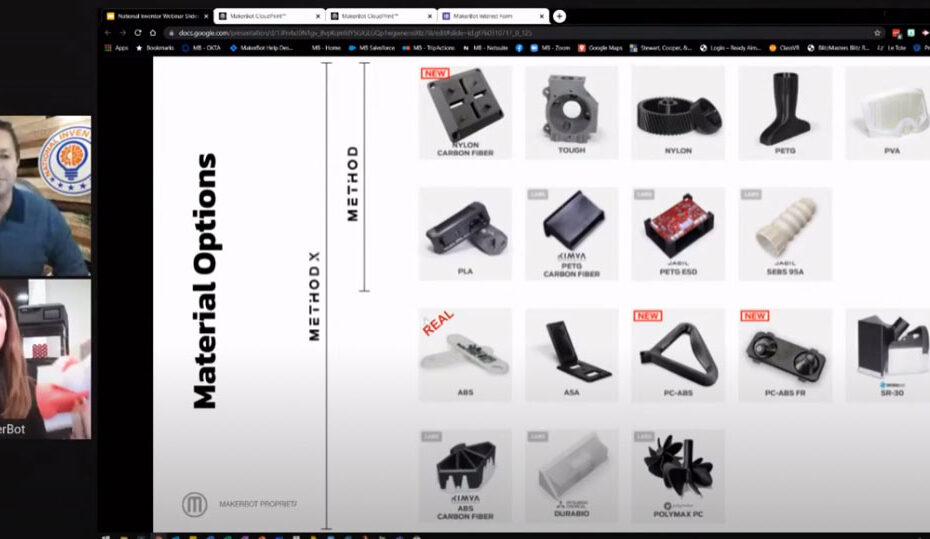
August 2022!
Whether you are an experienced inventor or a newbie who just came up with your first big idea, the Inventor Smart Monthly newsletter is for you! You will find valuable tips, useful resources and words of wisdom that can help you move your invention forward!
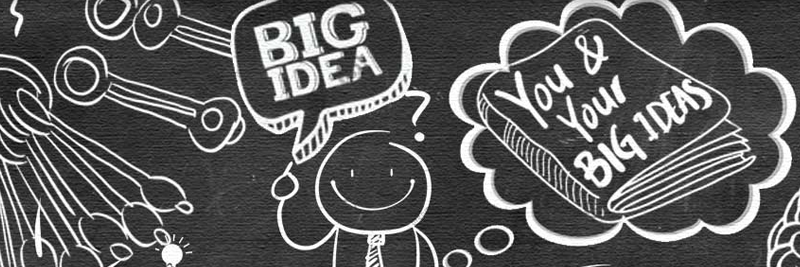
Evaluating Your Invention’s Market Potential
Options to Create a Prototype
If you’re on a shoestring budget or if you have money, the goal is to bring your idea to life – to get it in front of you and to have it look and function as close as possible to the real thing.
Let’s begin by finding the least expensive method of creating your prototype: building your prototype yourself. Find existing parts or similar products that you can take apart and reassemble to create a crude prototype of your invention. Do the best you can to make it look good and focus on the functionality of how it works.
It could take some time and effort, but creating your own prototype will save you money. It could cost you maybe $50 or less, depending on what materials or parts you are trying to find and use. Look around and see what you have already in your possession, or go shopping and see what you can find and what you need to make a prototype out of what already exists. Try to get as close to a works-like, looks-like prototype of your invention.
Should you have the funds to spend or if you can save up some money for a more professional-looking and working- like prototype, you can consider hiring a product designer or engineer to create CAD (Computer-Aided Design) drawings for you. Your idea’s design and parts are saved into special files that can be used to create your prototype. You can also use them for manufacturing and getting quotes for future production.
You can even go to your local library that may have 3D printers you can rent time to use, for a small fee. You can also call your local college’s engineering department and you can ask them for a student to help you create your prototype.
The ultimate goal is to get as close as possible to the real thing for yourself to be proud of, and for others to provide you with feedback. Remember, there might be a few iterations that you have to go through to get your prototype just right, but it doesn’t have to be perfect until you move to producing your finished product. Your prototype can even be used to demonstrate to a licensee for a potential licensing deal, or it can be used to prepare you for your future production to sell into retail.
Your idea, now brought to life with your prototype.
Source from book: How To Make Money with Your Invention Idea by Brian Fried

Bright Idea:
Inventor Tip from Brian Fried
Bright Idea: Property Licensing vs Product Licensing – Which Type is For Inventors?
So you came up with this great invention idea. Let’s say you invented an amazing one-of-a-kind can opener. One of its purposes is to open a can of beer in a very unique innovative way!
Now you’re thinking, wow, Budweiser or Coors (or pick your favorite brand) would love my idea and I should pitch to them and attempt to secure a licensing deal to earn royalties.
You start on your innovation journey, going through patent searching, product designing, prototyping, filing intellectual property to say you are patent pending, preparing your presentation and pitch and then we are ready to go! Let’s make some calls and send some emails… After figuring out who to speak to, you finally connect to a licensing manager at the company you are calling. The conversation is a bit confusing. Why?
The licensing manager is expecting to sell their brand they are representing to you and your product. You are thinking that you want to license your product to them.
Here is the confusion:
Bud or Coors makes beer and does not produce can openers. You look around and you see all these t-shirts, hats, and other items for you to display your brand of beer proud. So, where do I go and where did I go wrong?
The brand licensing manager is looking for manufacturers, companies that already have a sales history of producing products, which could be in various categories and offering their brand to you, as the licensor. Their terms vary, however expect to pay an advance on royalties to them up front and a royalty on every product sold.
As an inventor, we most likely do not qualify for this unless we plan on manufacturing and coming back to them in a few years when we do qualify. So, then what… How can an inventor see a brand property on their invention?
There are companies that have fit the brand requirements and are already paying that advance and paying royalties. Those are the companies that you may consider to license your invention. If they are an apparel company and they only sell t-shirts, they most likely are not covered for can openers, so look for companies related to what you’ve invented what they manufacture.
If they see your invention is a good fit, they will add your product to their product line, prepare concepts to the brand following the brand guidelines, once accepted will pitch the retail buyers and/or include in their online offerings. Now, your amazing one-of-a-kind can opener has the beer name branded, logo’ed on it and every time one of them sells, you finally earn your royalties… Congratulations!
Brian Fried

Question:
What conditions must be met to obtain patent protection?
Answer:
There are numerous conditions that must be met in order to obtain a patent and it is not possible to compile an exhaustive, universally applicable list. However, some of the key conditions include the following:
The invention must show an element of novelty; that is, some new characteristic which is not known in the body of existing knowledge in its technical field. This body of existing knowledge is called “prior art”.
The invention must involve an “inventive step” or “non-obvious”, which means that it could not be obviously deduced by a person having ordinary skill in the relevant technical field.
The invention must be capable of industrial application, meaning that it must be capable of being used for an industrial or business purpose beyond a mere theoretical phenomenon, or be useful.
Its subject matter must be accepted as “patentable” under law. In many countries, scientific theories, aesthetic creations, mathematical methods, plant or animal varieties, discoveries of natural substances, commercial methods, methods for medical treatment (as opposed to medical products) or computer programs are generally not patentable.
The invention must be disclosed in an application in a manner sufficiently clear and complete to enable it to be replicated by a person with an ordinary level of skill in the relevant technical field.

RSVP for the next National Inventor Club meeting on August 30th @ 8pm EST/5pm PST!
Topic: How and when to get funding to kickstart your invention or business.
-How to value your company or idea
-What type of funding is available?
You want to get your invention launched and you’re limited on funds… So what are your options to make your idea or startup a reality? Our Guest Speaker Richard Honen is an entrepreneurial attorney and an expert in venture capital from Phillips Lytle, LLC, to help answer the questions you always wonder what they’re always talking about on Shark Tank!
RSVP HERE with Free Membership
NIC past monthly meeting with Makerbot 3d Printer Company:
Creating a prototype is one of the things that us inventors need to do. In the October 2021 NIC meeting we had a chance to learn about the 3D printer MakerBot and how we can use it in creating a prototype.
Our Guest Speaker Dottie Stewart from MakerBot will teach us what 3D printing is, how it works and how it can be used for creating prototypes and low volume production for your invention. Maybe you’ll even buy your own 3D printer!
Did you know MakerBot is a global leader in the 3D printing industry and subsidiary of Stratasys. Founded in 2009 in Brooklyn, NY, MakerBot strives to redefine the standards for 3D printing for reliability, accessibility, precision, and ease-of-use. MakerBot has one of the largest install bases in the industry and also runs Thingiverse, the largest 3D printing community in the world. Discover innovation with MakerBot 3D printing.
National Inventor Club is one of the largest and most active communities for inventors, innovation, and service providers that support invention and continues to provide a nationwide platform for great guest speakers, networking, and connections founded and moderated by Brian Fried, who has been running inventors clubs for over 15 years.
To become a member, free or paid, for inventors and service providers, please join us at National Inventor Club: https://nationalinventorclub.com
Sponsorship opportunities are also available, email info@nationalinventorclub.com for more details.

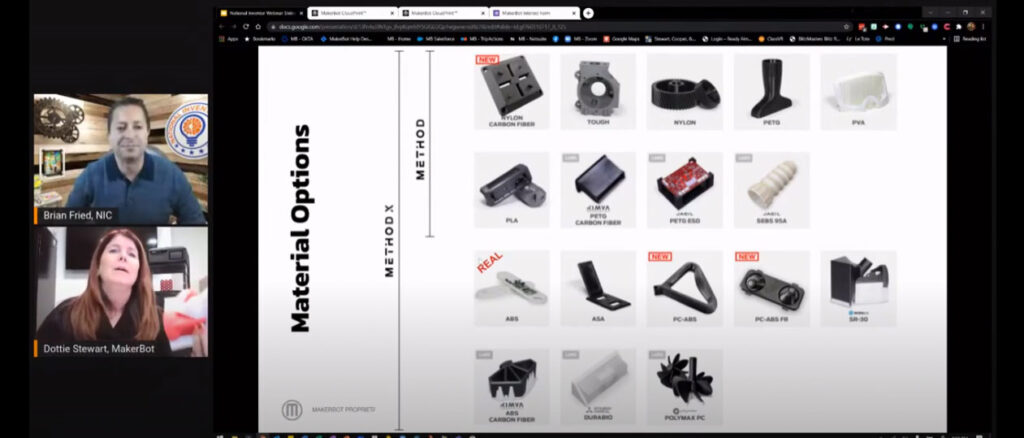
In case you missed this past NIC meeting with Makerbot 3D printers or you’d like to watch or hear it again, visit this link:

The Got Invention Show features a 30-minute interview where an inventor promotes an invention, seeks a licensing deal, or looks for distribution opportunities. Host Brian Fried focuses on his guest’s challenges and solutions. He asks about their journey, where they are right now, and what will come next. He invites guests to offer words of wisdom to viewers and listeners.
One of the latest episodes on Got Invention Show, Host Brian Fried features a New Innovative Patented Portable Seat Massager Searching for Licensing Deal the Epione X3 invented by Denise, Dorothy and Donna.
The Epione X3 is a patented portable seat massager you sit on that combines massager balls and rollers with vibration and includes heating and cooling features. The design specifically concentrates on the lower back, pelvis and coccyx areas of the body to relieve:
-Pelvic pain and congestion
-Help with constipation prostate congestion enlargement
-Hemorrhoids sacroiliac pain swelling of the legs tailbone pain
-Painful periods
-Bladder infections
Denise, Dorothy and Donna have been diligently working on securing a licensing deal with a brand in the portable massager industry that would manufacture and distribute their product and they would earn a royalties.
–Dr. Denise Burns is a board certified physician in Neuromusculoskeletal medicine/ Family Medicine, Professor Osteopathic Medicine at Touro University Chair, NMM department Touro University Author, fourth edition An Osteopathic Approach to Diagnosis and Treatment Recipient NY Top Doctor of year 2020-2022
–Dorothy Belnavi graduated from The University of Salford (UK) Master of Science in Marketing and has a Bachelor’s of Science in Social Science and Humanities (Politics and Anthropology) Certified Fitness Trainer Management Skills Development Trainer
–Donna Sbarro is a mother of 3 College Education at NY Institute of Technology Real Estate License Gift store owner for 10 years Restaurant Owner
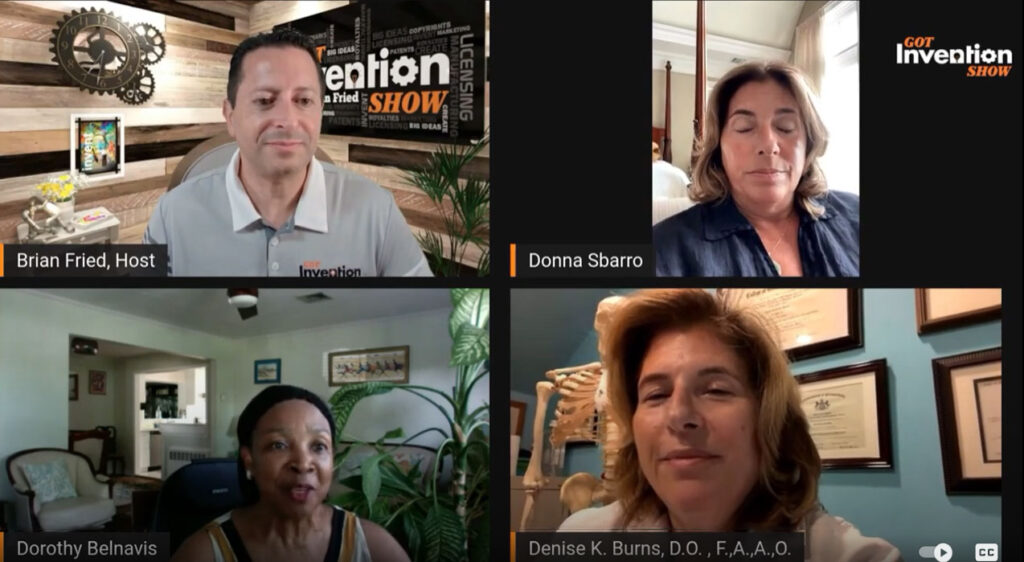
Would you like to be our guest on the Got Invention Show? Schedule your interview today to promote your prototype or product now available for sale to now reaching 100 million households!
You and Host Brian will do a 28 minute interview and once the interview is completed, you can use it for your website and social media and we air on Amazon Fire, Roku TV, YouTube TV and next month we will be on Apple TV!! The podcast audio version of your interview is played on Spotify, iHeartRadio, Google and Apple Podcasts and Amazon Music! Small fee, great promotion for you and your invention!!

News from the US Patent & Trademark Office (USPTO)
Free legal assistance for filing for a patent or registering a trademark, how to find a registered patent attorney or agent, and inventor and entrepreneur organizations in your state.
Finding a registered patent practitioner
The Office of Enrollment and Discipline (OED) maintains a register of active patent practitioners who are eligible to represent others before the United States Patent and Trademark Office (USPTO) in patent matters. Only registered patent attorneys and agents, and individuals granted limited recognition, may represent patent applicants before the USPTO. Individuals not listed on the register are generally unable to represent others before the USPTO in patent matters.
Visit their website for more information. https://www.uspto.gov/learning-and-resources/patent-and-trademark-practitioners/finding-patent-practitioner
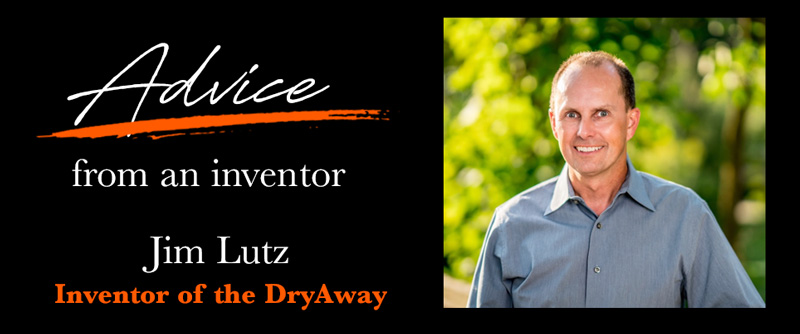
“Whether you are looking for a bank loan or a Capital Investor, the first step is to make sure youhave a solid business plan with financial projections. A great, free source to help make sure your projections are realistic and have the ratios that investors are looking for is to find your local SBA (Small Business Association) office and get a mentor. They also help with putting your projections in a format that investors are looking for, along with challenging you on the difficult questions you will face. It might take many interviews to find the lender that fits, but when you find the right one, they will be able to give you the support you need.”
Jim Lutz, Inventor and Owner of the DryAway, Eco-Friendly Laundry Drying Systems
DryAway is a series of frames for hang drying clothes, that easily pushes “Out of sight and Out of the way”. No energy or mess while drying your clothes without tumbling and heat damage. I was an athlete with workout clothes (and everyday clothes) that I dried on the traditional accordion racks so as not to damage them. My wife and I built a new home with a beautiful first floor laundry room which drove me to invent a better solution to hang dry my clothes out of sight. I’m a neat freak, Engineer by study and spent 30 years in financial sales as an NML agent and a residential loan officer. My diverse background allowed me to develop, manufacture, market, sell and get financing to take DryAway from an idea in my home, to something that is manufactured in large scale as a standard in laundry room design.
DryAway.net
Check out the ”How Does it Work” video
https://youtu.be/QaapSJvWACI
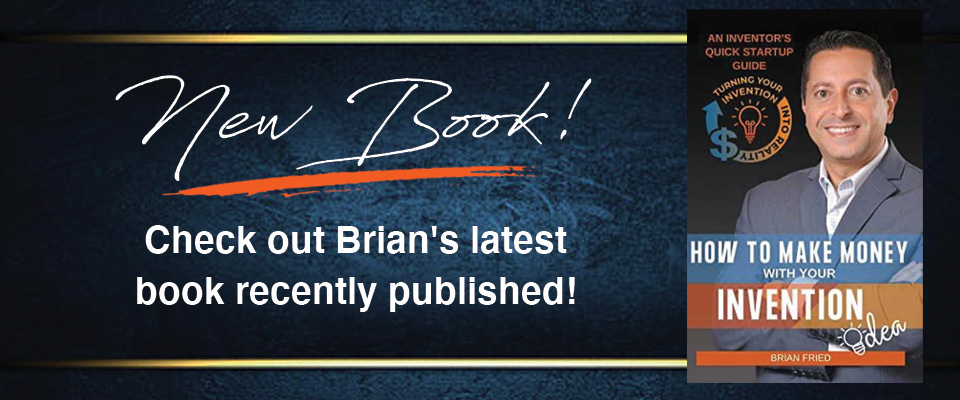
Do you have this great idea for an invention in your head? Are you ready to learn how to make money with that invention?
This book is about taking action so you can take that great idea out of your head and make smart decisions to help you make money. Here’s how it works:
We’re going to walk through the steps of getting started with your big idea.
We’ll also explore how to turn your idea into a real prototype.
We’ll discover resources to protect your ideas and, of course, help plan your future.
So why did I write this book? I want to provide the opportunity for more inventors to learn the process it takes to experience the invention brought to life. Not only to make your invention a reality, but to learn how to earn from your inventions.
Order your paperback or Kindle copy – Click here to go to Amazon
A shop for Inventors, innovators and patent holders - Check out InventorMart.com!

This is a shop for you! You’ve worked hard on your invention, now you can wear DESIGNS & MERCH made with you in mind! Find shirts, hoodies, sweatshirts, hats, stickers, blankets and over 1,000 unique items to show that you are proud to be an inventor. check out InventorMart.com
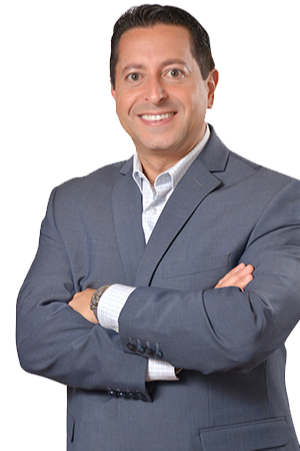
About Brian Fried
Brian Fried, serial inventor with 13 patents, is an award-winning authority in the invention industry, a sought-after celebrity guest speaker and an advocate for the invention community. As Chief Invention Officer of Inventor Smart and Expert Inventor Coach, Brian represents inventors at every stage of the invention process, project managing new up-and-coming inventions from idea to manufacturing or as an invention licensing agent to secure deals with major brands and earn royalties for inventors.
Brian is the founder of the National Inventor Club where guest speakers focus on topics of interest to the inventor community.
He is a 3x author and his 3rd book, How to Make Money With Your Invention Idea was just published in May 2022. He also hosts Got Invention Show and Radio where you can watch on RokuTV, Amazon Fire, YouTube TV, and you can hear his podcasts on Spotify, iHeartRadio, Amazon Music Google and Apple Podcasts. Brian recently launched a new merch line with various designs for inventors, InventorMart.com
You can visit Brian’s personal website at BrianFried.com and check out his invention that have been licensed where he earns royalties and manufactures others that he sells on his own currently found in retailers.
Brian’s Inventor MasterClass is now available! If you want to evaluate your invention, find out if licensing or manufacturing is the right decision for you, sign up for an eLearning course at InventorClass.com. National Inventor Club Members receive a discount. For inventor resources, more information and additional tips, visit Inventor Smart.

Sponsorship opportunities available for future newsletters. If you’d like to promote your product or service please contact info@inventorsmart.com or call (631)565-7074
Thank you for reading this and please subscribe to the newsletter on Linkedin for us to stay connected!
Inventively Yours,
Brian and the Inventor Smart Team
Past Newsletters

May Newsletter 2024
May 2024 Whether you’re an experienced inventor or a newbie who just came up with your first big idea, the Inventor Smart Monthly Newsletter is
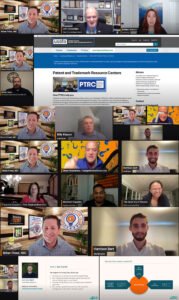
April Newsletter 2024
April 2024 Whether you’re an experienced inventor or a newbie who just came up with your first big idea, the Inventor Smart Monthly Newsletter is
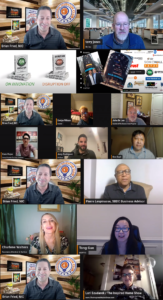
March Newsletter 2024
March 2024 Whether you’re an experienced inventor or a newbie who just came up with your first big idea, the Inventor Smart Monthly Newsletter is
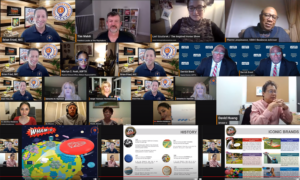
February Newsletter 2024
February 2024 Whether you’re an experienced inventor or a newbie who just came up with your first big idea, the Inventor Smart Monthly Newsletter is
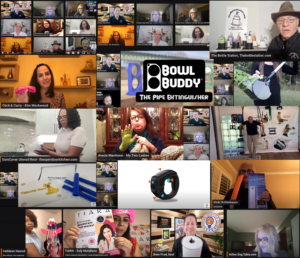
January Newsletter 2024
January 2024 Whether you’re an experienced inventor or a newbie who just came up with your first big idea, the Inventor Smart Monthly Newsletter is
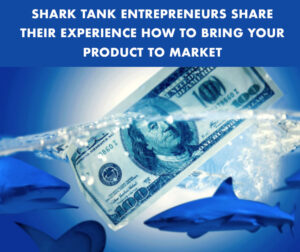
December Newsletter 2023
December 2023 Whether you’re experienced famous inventors or a newbie who just came up with your first big Invention idea, the Inventor Smart Monthly Newsletter

